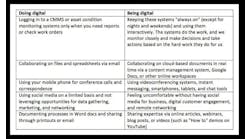By Chris McNamara, Smart Industry content director
Connectivity is wonderful. It is critical, actually, in this environment of smart systems, as networks increasingly connect with physical and digital worlds and the people who work with them.
These connections can create unusual relationships among suppliers, stakeholders, users and supporters who are partnering with one another in ways we could not have imagined just a few years ago. But as their business models have begun to intermingle, major players in the industrial arena continue to operate with hardened business models born out of the competencies that each group believes to be at its core.
As smart systems blur business models, manufacturers must rethink strategies and reconsider
longstanding relationships. Will this create strange bedfellows? Perhaps. But opportunities outweigh awkwardness when this connectivity is properly exploited.
Those opportunities were at the core of Harbor Research analyst Harry Pascarella’s presentation at Smart Industry 2018, which he kicked off with this simple declaration: “Going at it alone doesn’t work well.”
Ecosystems of ecosystems
Rather than simple partnerships, Pascarella outlined complex ecosystem structures—actually ecosystems of ecosystems—enabled by new technologies and tactics, from sensors providing greater levels of machine data to advanced use of device data by management to the practice of distributing data through information architectures.
Smart systems have been around for years, said Pascarella, but they are just now coming into their own, emerging, blossoming as they become digital. And there’s so much more we can do with them. “The ultimate example is smart cities with smart transportation networks,” dreamed the presenter.
These ideal scenarios are dependent on building a shared understanding among all stakeholders of the types of ecosystems that are emerging. Pascarella describe them like this:
• Economic ecosystems comprised of companies using a common architecture to deliver independent elements of an overall value proposition
• Platform ecosystems centered around solution enabling platforms for a particular economic ecosystem
• Solution ecosystems of companies that compete based on the vertically focused solutions they provide
• Company ecosystems built of the direct relationships that contribute to their competitive positions
Networking. Communication. Support. A shared mission among all participants. “Relationships will get closer as systems get more complex,” said Pascarella, sounding like a relationship counselor advising a couple considering starting a family.
Daunting? You bet. This presentation was a counterpoint to the start small and fail fast mantra espoused by many of the presenters at this conference. But this is a scaling approach—a next-step for those looking to deepen their commitment to their digital transformations.
Once you’ve started small…
Pascarella advised companies to take a technology-first mindset—employing new tools at our disposal to link people, processes and equipment. Likewise, he said, it is critical to fully understand the players—knowing which roles in value-delivery chains will drive the desired outcomes.
The good news is that these technology suppliers, OEMs, service-providers, users and customers (the savvy ones at least) are embracing this approach. And the goal of establishing these interconnected networks of ecosystems is simple: creating value.
Pascarella drilled down into benefits—democratized distribution to the edge, interoperability and scalability of successes, the ability to be database-independent, less ownership of ideas and technology, more fluid relationships among partners, etc.
In a nutshell, this approach creates expanded capabilities and expanded market delivery for the enterprise, resulting in not just optimized processes, but wholly new revenue models.
There are front-runners. Pascarella cited Shell, Yokogawa and Cisco as enterprises doing this level of advanced connectivity right. “It’s the idea of customer co-development,” he explained. “Customers have unique requirements. It is critical to meet those custom needs via collaboration and co-development with them. And a lot goes back to the value of data. Can you leverage it for the customer and for other OEMs and service providers?”
With most businesses, there needs to be an evolution of the entire business model to get there. But the benefits of restructuring your universe of partnerships—and in doing so reconsidering relationships with strange bedfellows—are proven. “When these systems open up and allow for data to flow across them, then new revenue models come to bear. We have to understand that we all benefit from sharing.”

